For the 2025 school year, there are 2 public elementary schools serving 507 students in Hobart School District. This district's average elementary testing ranking is 7/10, which is in the top 50% of public elementary schools in Oklahoma.
Public Elementary Schools in Hobart School District have an average math proficiency score of 27% (versus the Oklahoma public elementary school average of 26%), and reading proficiency score of 29% (versus the 26% statewide average).
Minority enrollment is 46% of the student body (majority Hispanic), which is less than the Oklahoma public elementary school average of 56% (majority Hispanic and American Indian).
Overview
This School District
This State (OK)
# Schools
3 Schools
1,195 Schools
# Students
704 Students
468,733 Students
# Teachers
46 Teachers
29,021 Teachers
Student : Teacher Ratio
15:1
15:1
District Rank
Hobart School District, which is ranked within the top 50% of all 533 school districts in Oklahoma (based off of combined math and reading proficiency testing data) for the 2021-2022 school year.
The school district's graduation rate of 80-89% has decreased from 85-89% over five school years.
Overall District Rank
#214 out of 538 school districts
(Top 50%)
(Top 50%)
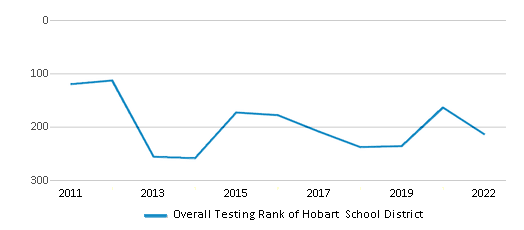
Math Test Scores (% Proficient)
25%
25%
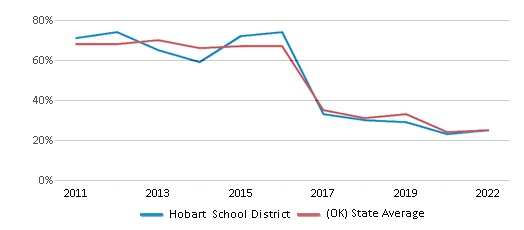
Reading/Language Arts Test Scores (% Proficient)
29%
27%
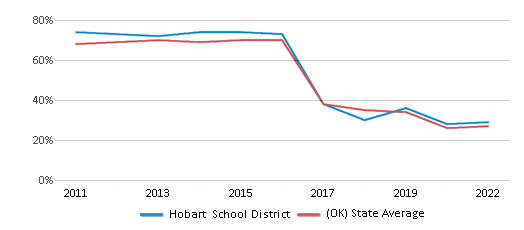
Science Test Scores (% Proficient)
40-44%
31%
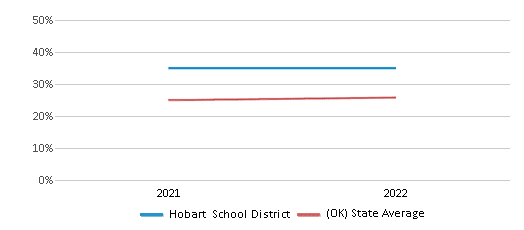
Graduation Rate
(20-21)80-89%
78%
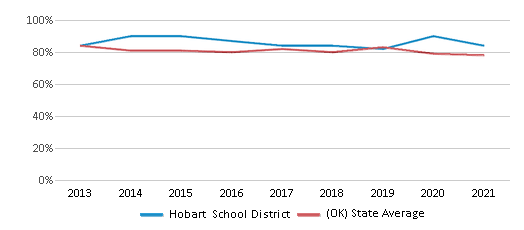
Students by Ethnicity:
Diversity Score
0.64
0.74
# American Indian Students
22 Students
50,937 Students
% American Indian Students
3%
11%
# Asian Students
3 Students
10,304 Students
% Asian Students
1%
2%
# Hispanic Students
149 Students
95,345 Students
% Hispanic Students
21%
20%
# Black Students
58 Students
38,067 Students
% Black Students
8%
8%
# White Students
385 Students
204,933 Students
% White Students
55%
44%
# Hawaiian Students
n/a
2,207 Students
% Hawaiian Students
n/a
1%
# Two or more races Students
87 Students
66,841 Students
% of Two or more races Students
12%
14%
Students by Grade:
# Students in PK Grade:
37
32,740
# Students in K Grade:
54
46,403
# Students in 1st Grade:
54
51,638
# Students in 2nd Grade:
41
51,822
# Students in 3rd Grade:
56
51,866
# Students in 4th Grade:
43
51,270
# Students in 5th Grade:
50
51,780
# Students in 6th Grade:
67
52,317
# Students in 7th Grade:
53
40,079
# Students in 8th Grade:
52
38,542
# Students in 9th Grade:
61
66
# Students in 10th Grade:
55
76
# Students in 11th Grade:
43
63
# Students in 12th Grade:
38
71
# Ungraded Students:
-
-
District Revenue and Spending
The revenue/student of $11,979 is higher than the state median of $10,983. The school district revenue/student has stayed relatively flat over four school years.
The school district's spending/student of $12,024 is higher than the state median of $10,957. The school district spending/student has stayed relatively flat over four school years.
Total Revenue
$8 MM
$7,919 MM
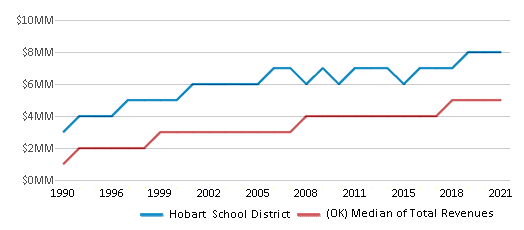
Spending
$9 MM
$7,900 MM
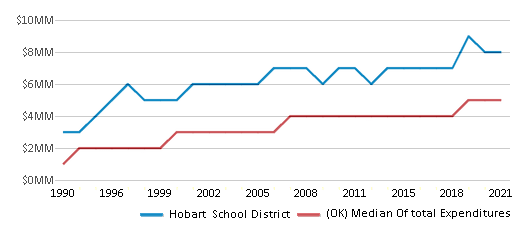
Revenue / Student
$11,979
$10,983

Spending / Student
$12,024
$10,957
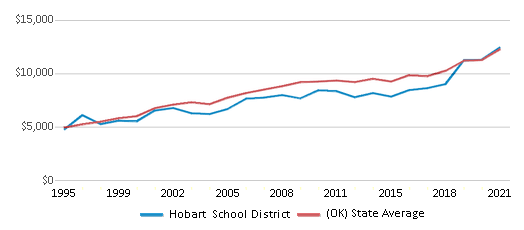
Best Hobart School District Public Elementary Schools (2025)
School
(Math and Reading Proficiency)
(Math and Reading Proficiency)
Location
Grades
Students
Rank: #11.
Hobart Middle School
(Math: 30-34% | Reading: 35-39%)
Rank:
Rank:
8/
Top 30%10
410 N Jefferson Street
Hobart, OK 73651
(580) 726-5615
Hobart, OK 73651
(580) 726-5615
Grades: 6-8
| 172 students
Rank: #22.
Hobart Elementary School
(Math: 20-24% | Reading: 20-24%)
Rank:
Rank:
5/
Bottom 50%10
115 W Iris
Hobart, OK 73651
(580) 726-5665
Hobart, OK 73651
(580) 726-5665
Grades: PK-5
| 335 students
Recent Articles

Year-Round Or Traditional Schedule?
Which is more appropriate for your child? A year-round attendance schedule or traditional schedule? We look at the pros and cons.

Why You Should Encourage Your Child to Join a Sports Team
Participating in team sports has a great many benefits for children, there is no doubt. In this article you will learn what those benefits are.

White Students are Now the Minority in U.S. Public Schools
Increasing birth rates among immigrant families from Asia and Central and South America, combined with lower birth rates among white families, means that for the first time in history, public school students in the United States are majority-minority. This shift in demographics poses difficulties for schools as they work to accommodate children of varying language abilities and socio-economic backgrounds.





